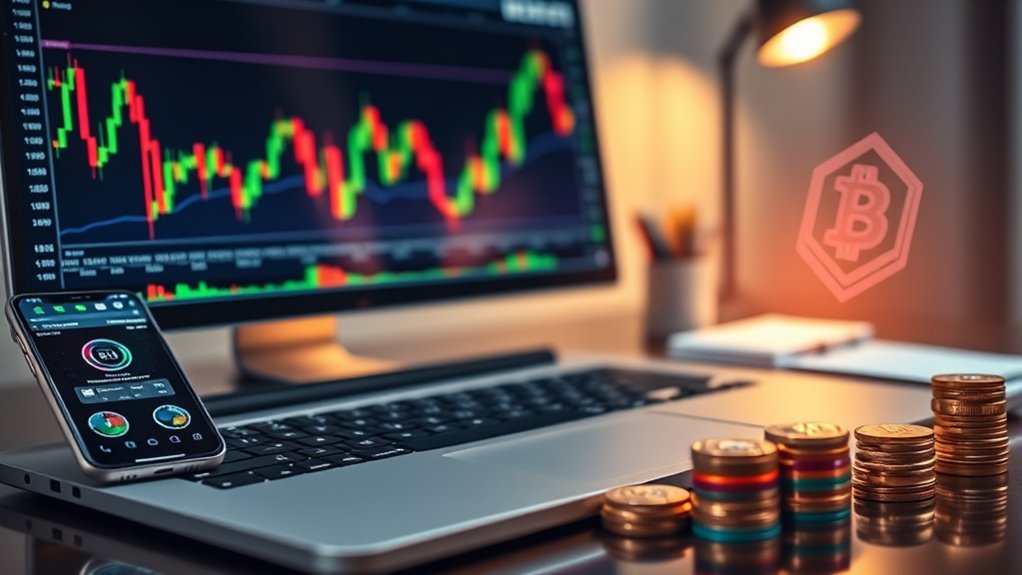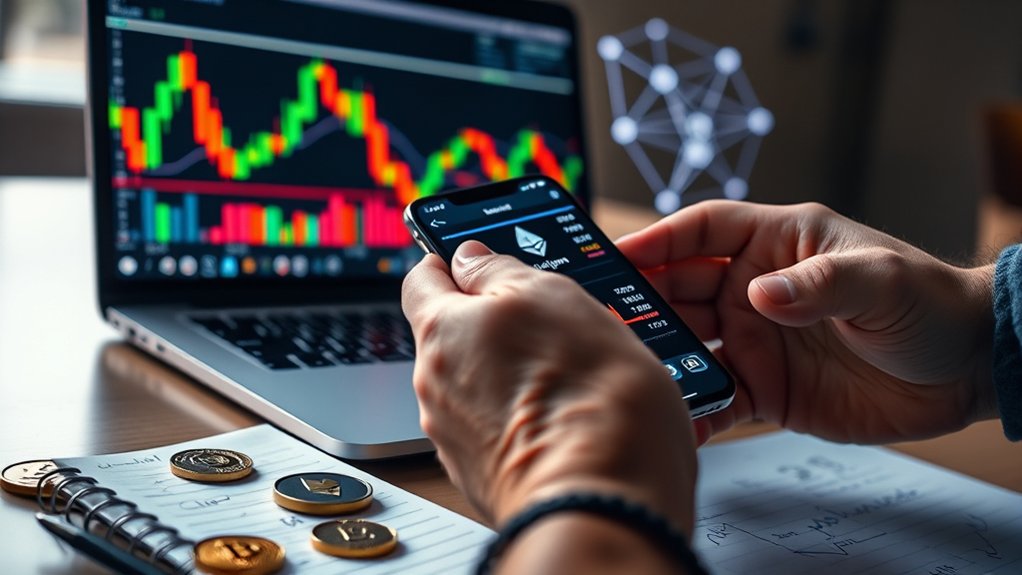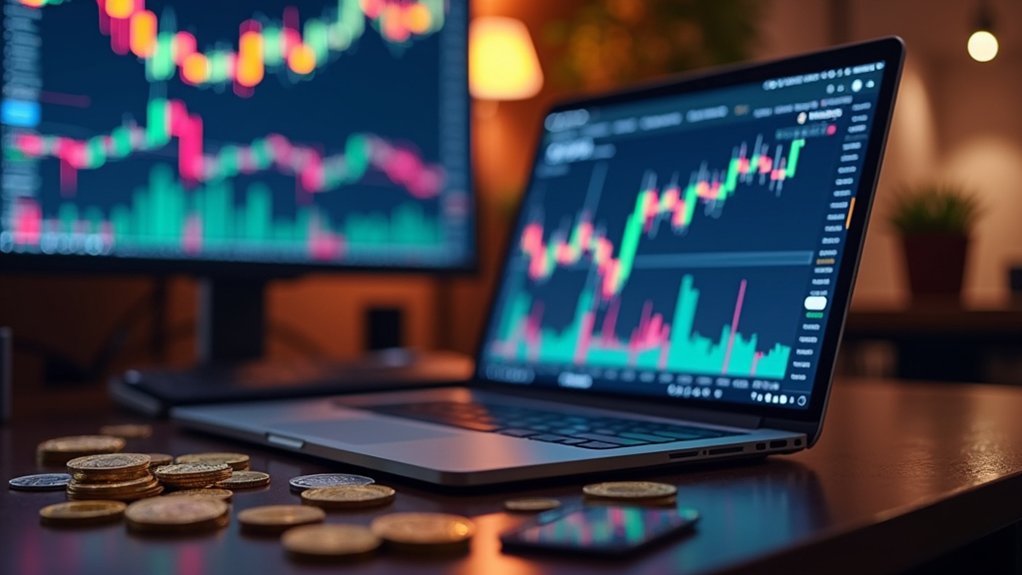Cryptocurrency trading is like a rollercoaster ride—fast and wildly unpredictable. It happens 24/7 on exchanges where traders buy and sell digital assets. There’s Bitcoin, the rockstar, and a bunch of lesser-known altcoins just trying to get a piece of the action. But hey, it’s not all fun. Security’s a big deal; hacks happen. Traders use fancy charts and strategies to make sense of it all. Want to know more about how to tackle this chaotic arena? There’s plenty ahead.

Cryptocurrency trading might sound like a wild ride, but it’s really just a chaotic dance with volatility. Prices soar and plummet like a rollercoaster. Some traders thrive on this unpredictability, chasing profits as prices swing. Others? They just hang on for dear life.
Cryptocurrency trading is a thrilling rollercoaster of volatility, where profits swing wildly and traders either thrive or just hang on tight.
The crypto market is open 24/7. Yes, that’s right—no sleep for the weary. You can trade at any hour, anywhere. It’s a trader’s paradise or nightmare, depending on how you look at it. This continuous trading is facilitated by crypto exchanges, which ensure fast and secure transactions.
Decentralization is the secret sauce here. Transactions happen without pesky intermediaries. Blockchain technology makes it all possible. But, hold on! With great power comes great responsibility—or in this case, security risks. Hacking and exchange breaches are real threats. It’s not all sunshine and rainbows.
Choose an exchange wisely. Look for security features like two-factor authentication. Cold storage? Yes, please. And don’t forget to check those fees. Trading shouldn’t break the bank.
Now, let’s talk about the different types of cryptocurrencies. Bitcoin is the rockstar of the bunch. But, hey, don’t sleep on altcoins like Ethereum and Ripple. Stablecoins are there to play it safe, pegged to real-world assets. And then there are NFTs—because who doesn’t want to own a digital cat?
When trading, understanding the landscape is essential. Fundamental analysis helps assess a cryptocurrency’s tech and use cases. Market volatility matters, folks! The high volatility of cryptocurrencies presents both risks and opportunities for traders. Keep an eye on market sentiment, too.
Technical analysis is a whole other ballgame. Price charts reveal patterns, and indicators like Moving Averages help spot trends. Support and resistance levels? Those are vital to know.
Trading strategies vary widely. Day trading is for the bold, while HODLing appeals to the patient. There’s something for everyone in this crypto circus. Welcome to the world of cryptocurrency trading, where chaos reigns supreme!
Frequently Asked Questions
What Are the Tax Implications of Cryptocurrency Trading?
When it comes to cryptocurrency trading, taxes can be a real headache.
Every trade? Taxable. Using crypto to buy a pizza? Yep, taxable. Mining or staking? Say hello to income taxes.
Even converting crypto to dollars isn’t tax-free. Capital gains tax hits profits, and depending on how long you hold, you could get slapped with different rates.
It’s a maze. Keep records, or face the taxman’s wrath. Good luck with that!
How Do I Secure My Cryptocurrency Wallet?
Securing a cryptocurrency wallet isn’t just smart; it’s crucial.
First off, use strong passwords. Don’t rely on “123456.” Try two-factor authentication—because who doesn’t love an extra step?
Store private keys offline; hardware wallets are your friends.
And please, don’t access wallets over sketchy public Wi-Fi. Seriously, that’s like inviting trouble.
Regular updates are a must.
What Are the Risks of Trading Cryptocurrencies?
Trading cryptocurrencies? Buckle up. It’s a wild ride.
Volatility can turn smiles into frowns in seconds. Liquidity? Good luck offloading that big stash when everyone else is panicking.
Regulatory changes? They hit like a surprise pop quiz. And don’t even get started on security—hackers love crypto like kids love candy.
Scams? They’re everywhere.
Can I Trade Cryptocurrencies on My Mobile Device?
Absolutely, trading cryptocurrencies on a mobile device is a thing. It’s convenient, right? Just whip out your phone and trade anytime, anywhere.
But hold on—there are risks. Security issues lurk everywhere. A missed internet connection? That’s a bummer. Emotional trading can turn into a disaster.
Sure, apps have cool features, but if you think you’re invincible, think again. Mobile trading is easy, but it’s not always safe or smart.
How Do I Choose a Cryptocurrency Exchange?
Choosing a cryptocurrency exchange? It’s like picking a car. You want reliability, security, and a good reputation—no one wants a lemon.
Look for features like two-factor authentication and a user-friendly interface. Check if they support a variety of coins and trading pairs.
And please, don’t overlook customer support; you’ll need that when things go sideways.





